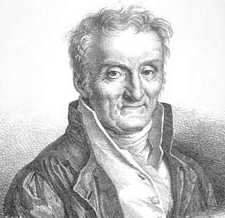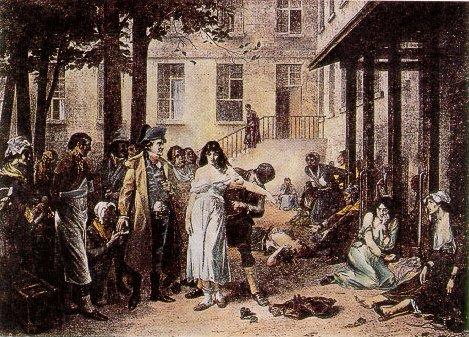<Back to Index>
- Physician Philippe Pinel, 1745
- Painter and Sculptor Joan Miró i Ferrà, 1893
- Emperor of France Napoléon III, 1808


Philippe Pinel (20 April 1745 - 25 October 1826) was a French physician who was instrumental in the development of a more humane psychological approach to the custody and care of psychiatric patients, referred to today as moral treatment. He also made notable contributions to the classification of mental disorders and has been described by some as "the father of modern psychiatry".
Pinel was born in Saint-André, Tarn, France, the son and nephew of physicians. After receiving a degree from the faculty of medicine in Toulouse, he studied an additional four years at the Faculty of Medicine of Montpellier. He arrived in Paris in 1778. He spent fifteen years earning his living as a writer, translator, and editor because the restrictive regulations of the old regime prevented him from practicing medicine. The Paris faculty did not recognize a degree from a provincial university like Toulouse. He failed twice in a competition which would have awarded him funds to continue his studies. In the second competition the jury stressed his ‘painful’ mediocrity in all areas of medical knowledge, an assessment seemingly so grossly incompatible with his later intellectual accomplishments that political motives have been suggested. Discouraged, Pinel considered emigrating to America. In 1784 he became editor of the not very prestigious Gazette de santé, a four-page weekly.
At about this time he began to develop an intense interest in the study of mental illness. The incentive was a personal one. A friend had developed a ‘nervous melancholy’ that had ‘degenerated into mania’ and resulted in suicide. What Pinel regarded as an unnecessary tragedy due to gross mismanagement seems to have haunted him. It led him to seek employment at one of the best-known private sanatoria for the treatment of insanity in Paris. He remained there for five years prior to the Revolution, gathering observations on insanity and beginning to formulate his views on its nature and treatment. Pinel was an Ideologue, a disciple of the abbé de Condillac. He was also a clinician who believed that medical truth was derived from clinical experience. Hippocrates was his model.
During the 1780s Pinel was invited to join the salon of Madame Helvétius.
Pinel was in sympathy with the Revolution. After the revolution,
friends he had met at Madame Helvétius’ salon came to power. In
August 1793 Pinel was appointed "physician of the infirmeries" at Bicêtre Hospital.
At the time it housed about four thousand imprisoned men--criminals,
petty offenders, syphilitics, pensioners and about two hundred mental
patients. Pinel’s patrons hoped that his appointment would lead to
therapeutic initiatives. His experience at the private sanatoria made
him a good candidate for the job. Soon
after his appointment to Bicêtre, Pinel became interested in the
seventh ward where 200 mentally ill men were housed. He asked for a
report on these inmates. A few days later he received a table with
comments from the "governor" Jean-Baptiste Pussin (1745-1811). In the 1770s Pussin had been successfully treated for scrofula at Bicêtre; and, following a familiar pattern, he was eventually recruited, along with his wife, Marguerite Jubline, onto the staff of the hospice. Appreciating
Pussin’s outstanding talent, Pinel virtually apprenticed himself to
that unschooled but experienced custodian of the insane. His purpose in
doing this was to "enrich the medical theory of mental illness with all
the insights that the empirical approach affords. What he observed was
a strict nonviolent, nonmedical management of mental patients came to
be called moral treatment, though psychological might be a more accurate translation of the French ‘moral’. Although
Pinel always gave Pussin the credit he deserved, a legend grew up about
Pinel single-handedly liberating the insane from their chains. This
legend has been commemorated in paintings and prints. In fact, It was
Pussin who replaced iron shackles with straitjackets at Bicêtre
in 1797, after Pinel had left for the Salpêtrière. Pinel
followed Pussin's example three years later, after bringing Pussin to
the Salpêtrière. In addition, Italian physician Vincenzo Chiarugi is now recognised as having liberated psychiatric patients from chains before Pinel. While
at Bicêtre, Pinel did away with bleeding, purging, and blistering
in favor of a therapy that involved close contact with and careful
observation of patients. Pinel visited each patient, often several
times a day, and took careful notes over two years. He engaged them in
lengthy conversations. His objective was to assemble a detailed case
history and a natural history of the patient's illness. In 1795, Pinel became chief physician of the Hospice de la Salpêtrière,
a post that he retained for the rest of his life. The
Salpêtrière was, at the time, like a large village, with
seven thousand elderly indigent and ailing women, an entrenched
bureaucracy, a teeming market and huge infirmaries. Pinel missed
Pussin, and in 1802 secured his transfer to the
Salpêtrière. Pinel created an inoculation clinic in his
service at the Salpêtrière in 1799 and the first
vaccination in Paris was given there in April 1800. A statue in his honour stands outside the Salpêtrière. In
1795 Pinel was also appointed as a professor of medical pathology, a
chair that he held for twenty years. He was briefly dismissed from this
position in 1822, with ten other professors, suspected of political
liberalism, but reinstated as an honorary professor shortly thereafter. In 1798 Pinel published an authoritative classification of diseases in his Nosographie philosophique ou méthode de l'analyse appliquée à la médecine. Although he is properly considered one of the founders of psychiatry, this book establishes him as the last great nosologist of the eighteenth century. While the Nosographie appears
completely dated today, it was so popular in its time that it went
through six editions between its initial publication and 1818. In his book Traité médico-philosophique sur l'aliénation mentale; ou la manie, published in 1801, Pinel discusses his psychologically oriented approach. This book was translated into English by D. D. Davis as a Treatise on Insanity in
1806. It had an enormous influence on both French and Anglo-American
psychiatrists during the nineteenth century. In 1802 Pinel published La Médecine Clinique which
was based on his experiences at the Salpêtrière and in
which he extended his previous book on classification and disease. Pinel
was elected to the Académie des Sciences in 1804 and was a
member of the Académie de Médecine from its founding in
1820. He died in Paris in 1826. Foucault's influential book, "Madness and Civilization: A History of Insanity in the Age of Reason" focuses on Pinel, along with Tuke, as the driving force behind the shift from physical to mental oppression.